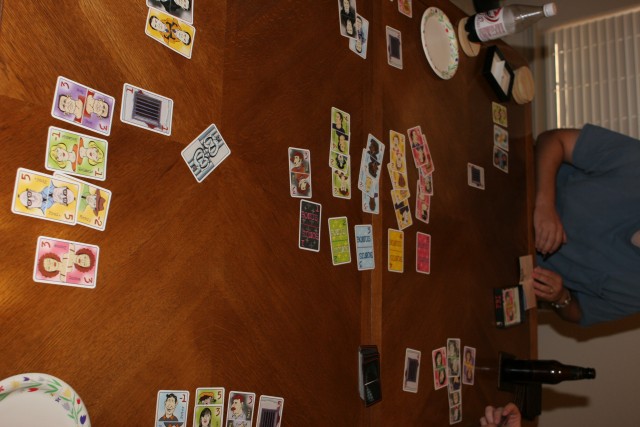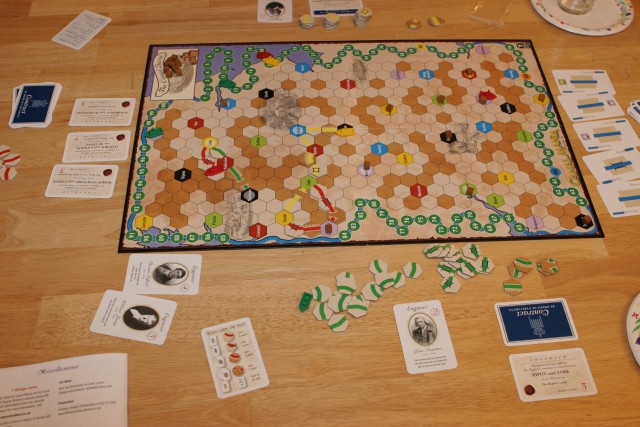
I keep Klunker on my table because I would like to play it. And tonight seemed like the night. We were looking for a quick game to start off with and I thought that game would it. But John hosed me by bringing FBI to the table. Since I didn’t know the rules to Klunker and John knew the rules to FBI, everyone agreed to play it. Sigh.
The game has a Take 6 feel to it. There are plus and minus cards in the game in five suits (colors). Every round, we will deal out ten of them. Next, people will either advance a card or not. (You can get rid of negative cards but this will cause you to go later rather than earlier). This will determine the order of play for the round. Then everyone picks to cards and simultaneously reveals them. These cards will determine which suit you must choose from. The first player reveals one of the face down cards and picks a card in the middle of the table in that suit. Play continues in the order determined until the last player goes. That person gets to take two cards. And then play goes in reverse order until the first player gets their last card.
So, you usually try to give up a high valued card in order to go first. This will atleast allow you to be guaranteed of getting one good card. The second one is a crap shoot. Unless you are lucky enough to have a pile that has no negative cards in it out there. Then you can choose that suit and not be disapointed if it is empty when it gets back to you.
At the end of the game, we determine who got majorities in the different suites for bonus cards (from +5 to +1). And your score is the total of the cards and any bonus cards.

I am on Boulder Game’s mailing list. And when I received one of their notes, I noticed that they had Canal Mania coming soon at a pretty good price. So I jumped on it. And got the game quicker than Ed and Susan did (they pre-ordered directly through the publisher’s site).
This game is a mix of Ticket to Ride and Age of Steam. You build canal segments on the map. There are four kinds of segments (stretch, lock, aqueduct, and tunnel) and the restriction is that you cannot have two of the same kinds of segments next to each other. During the game, you can either collect cards that are displayed face up, or build canals. When you build, you play the appropriate cards (some are harder to build and require more cards: like the aqueduct (2 aqueduct cards) or the tunnel (3 tunnel cards)) and then score points (not much though: 0,1,2, or 3 points per tile). There are engineers in the game that will lend you their special powers (draw one more card, build with one less card, etc).
The other aspect of this game is the delivery of goods. You may deliver goods from one city or town to another. Goods must move along canals and cannot move into a color more than once (for a maximum of 6). Points are scored for cities that are connected by player’s canals. So, along a three town path connected by two players, both players will score 2.
The production value is pretty good (although the cards could be coated). And, instead of the usual tea-towel board, The Ragnar Brothers went with a cardboard board (yea! much nicer). I would rate this game as a middle weight, meaty game. And one that I hope to play again…
